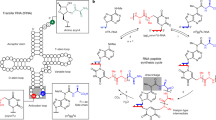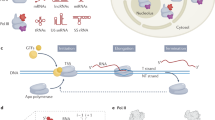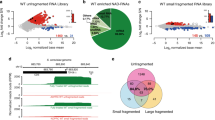Abstract
The universality of ribonuclease P (RNase P), the ribonucleoprotein essential for transfer RNA (tRNA) 5′ maturation1,2, is challenged in the archaeon Nanoarchaeum equitans. Neither extensive computational analysis of the genome nor biochemical tests in cell extracts revealed the existence of this enzyme. Here we show that the conserved placement of its tRNA gene promoters allows the synthesis of leaderless tRNAs, whose presence was verified by the observation of 5′ triphosphorylated mature tRNA species. Initiation of tRNA gene transcription requires a purine, which coincides with the finding that tRNAs with a cytosine in position 1 display unusually extended 5′ termini with an extra purine residue. These tRNAs were shown to be substrates for their cognate aminoacyl-tRNA synthetases. These findings demonstrate how nature can cope with the loss of the universal and supposedly ancient RNase P through genomic rearrangement at tRNA genes under the pressure of genome condensation.
This is a preview of subscription content, access via your institution
Access options
Subscribe to this journal
Receive 51 print issues and online access
$199.00 per year
only $3.90 per issue
Buy this article
- Purchase on Springer Link
- Instant access to full article PDF
Prices may be subject to local taxes which are calculated during checkout




Similar content being viewed by others
References
Altman, S. et al. Catalysis by the RNA subunit of RNase P — a minireview. Gene 82, 63–64 (1989)
Evans, D., Marquez, S. M. & Pace, N. R. RNase P: interface of the RNA and protein worlds. Trends Biochem. Sci. 31, 333–341 (2006)
Vögeli, G., Grosjean, H. & Söll, D. A method for the isolation of specific tRNA precursors. Proc. Natl Acad. Sci. USA 72, 4790–4794 (1975)
Guerrier-Takada, C., Gardiner, K., Marsh, T., Pace, N. & Altman, S. The RNA moiety of ribonuclease P is the catalytic subunit of the enzyme. Cell 35, 849–857 (1983)
Pannucci, J. A., Haas, E. S., Hall, T. A., Harris, J. K. & Brown, J. W. RNase P RNAs from some Archaea are catalytically active. Proc. Natl Acad. Sci. USA 96, 7803–7808 (1999)
Kikovska, E., Svard, S. G. & Kirsebom, L. A. Eukaryotic RNase P RNA mediates cleavage in the absence of protein. Proc. Natl Acad. Sci. USA 104, 2062–2067 (2007)
Tsai, H. Y., Pulukkunat, D. K., Woznick, W. K. & Gopalan, V. Functional reconstitution and characterization of Pyrococcus furiosus RNase P. Proc. Natl Acad. Sci. USA 103, 16147–16152 (2006)
Li, Y. & Altman, S. In search of RNase P RNA from microbial genomes. RNA 10, 1533–1540 (2004)
Willkomm, D. K., Feltens, R. & Hartmann, R. K. tRNA maturation in Aquifex aeolicus . Biochimie 84, 713–722 (2002)
Klein, R. J., Misulovin, Z. & Eddy, S. R. Noncoding RNA genes identified in AT-rich hyperthermophiles. Proc. Natl Acad. Sci. USA 99, 7542–7547 (2002)
Randau, L., Münch, R., Hohn, M. J., Jahn, D. & Söll, D. Nanoarchaeum equitans creates functional tRNAs from separate genes for their 5′- and 3′-halves. Nature 433, 537–541 (2005)
Palmer, J. R. & Daniels, C. J. In vivo definition of an archaeal promoter. J. Bacteriol. 177, 1844–1849 (1995)
Crooks, G. E., Hon, G., Chandonia, J. M. & Brenner, S. E. WebLogo: a sequence logo generator. Genome Res. 14, 1188–1190 (2004)
Hausner, W. & Thomm, M. in Archaea, Evolution, Physiology and Molecular Biology (eds. Garrett, R. A. & Klenk, H. P.) 185–198 (Blackwell, Malden, Massachusetts, 2007)
Kobayashi, T. et al. Structural basis for orthogonal tRNA specificities of tyrosyl-tRNA synthetases for genetic code expansion. Nature Struct. Biol. 10, 425–432 (2003)
Farruggio, D., Chaudhuri, J., Maitra, U. & RajBhandary, U. L. The A1 ˙ U72 base pair conserved in eukaryotic initiator tRNAs is important specifically for binding to the eukaryotic translation initiation factor eIF2. Mol. Cell. Biol. 16, 4248–4256 (1996)
Marck, C. & Grosjean, H. tRNomics: analysis of tRNA genes from 50 genomes of Eukarya, Archaea, and Bacteria reveals anticodon-sparing strategies and domain-specific features. RNA 8, 1189–1232 (2002)
Connolly, S. A., Rosen, A. E., Musier-Forsyth, K. & Francklyn, C. S. G-1:C73 recognition by an arginine cluster in the active site of Escherichia coli histidyl-tRNA synthetase. Biochemistry 43, 962–969 (2004)
Gupta, R. Halobacterium volcanii tRNAs. Identification of 41 tRNAs covering all amino acids, and the sequences of 33 class I tRNAs. J. Biol. Chem. 259, 9461–9471 (1984)
Shuman, S., Surks, M., Furneaux, H. & Hurwitz, J. Purification and characterization of a GTP-pyrophosphate exchange activity from vaccinia virions. J. Biol. Chem. 255, 11588–11598 (1980)
Noren, C. J. et al. In vitro suppression of an amber mutation by a chemically aminoacylated transfer RNA prepared by runoff transcription. Nucleic Acids Res. 18, 83–88 (1990)
Walker, S. C. & Engelke, D. R. Ribonuclease P: the evolution of an ancient RNA enzyme. Crit. Rev. Biochem. Mol. Biol. 41, 77–102 (2006)
Waters, E. et al. The genome of Nanoarchaeum equitans: insights into early archaeal evolution and derived parasitism. Proc. Natl Acad. Sci. USA 100, 12984–12988 (2003)
Das, S., Paul, S., Bag, S. K. & Dutta, C. Analysis of Nanoarchaeum equitans genome and proteome composition: indications for hyperthermophilic and parasitic adaptation. BMC Genomics 7, 186 (2006)
She, Q., Shen, B. & Chen, L. Archaeal integrases and mechanisms of gene capture. Biochem. Soc. Trans. 32, 222–226 (2004)
Altman, S., Kirsebom, L. & Talbot, S. Recent studies of ribonuclease P. FASEB J. 7, 7–14 (1993)
Fitz-Gibbon, S. T. et al. Genome sequence of the hyperthermophilic crenarchaeon Pyrobaculum aerophilum . Proc. Natl Acad. Sci. USA 99, 984–989 (2002)
Hartmann, E. & Hartmann, R. K. The enigma of ribonuclease P evolution. Trends Genet. 19, 561–569 (2003)
Randau, L. et al. The heteromeric Nanoarchaeum equitans splicing endonuclease cleaves non-canonical bulge–helix–bulge motifs of joined tRNA halves. Proc. Natl Acad. Sci. USA 102, 17934–17939 (2005)
Sprinzl, M. & Vassilenko, K. S. Compilation of tRNA sequences and sequences of tRNA genes. Nucleic Acids Res. 33, D139–D140 (2005)
Fechter, P., Rudinger, J., Giegé, R. & Théobald-Dietrich, A. Ribozyme processed tRNA transcripts with unfriendly internal promoter for T7 RNA polymerase: production and activity. FEBS Lett. 436, 99–103 (1998)
Studier, F. W. Protein production by auto-induction in high density shaking cultures. Protein Expr. Purif. 41, 207–234 (2005)
Acknowledgements
We thank P. O’Donoghue, J. Yuan and L. Sherrer for help and encouragement. This work was supported by grants from the National Institute of General Medical Sciences and the Department of Energy (D.S.) and the National Science Foundation (I.S.).
Author information
Authors and Affiliations
Corresponding author
Supplementary information
Supplementary Figures
The file contains Supplementary Figures S1-S2 wit Legends. (PDF 2465 kb)
Rights and permissions
About this article
Cite this article
Randau, L., Schröder, I. & Söll, D. Life without RNase P. Nature 453, 120–123 (2008). https://doi.org/10.1038/nature06833
Received:
Accepted:
Issue Date:
DOI: https://doi.org/10.1038/nature06833
This article is cited by
-
P finder: genomic and metagenomic annotation of RNase P RNA gene (rnpB)
BMC Genomics (2020)
-
Thermophile archaea — RNA im Kochtopf
BIOspektrum (2014)
-
Insights into archaeal evolution and symbiosis from the genomes of a nanoarchaeon and its inferred crenarchaeal host from Obsidian Pool, Yellowstone National Park
Biology Direct (2013)
-
RNA processing in the minimal organism Nanoarchaeum equitans
Genome Biology (2012)
Comments
By submitting a comment you agree to abide by our Terms and Community Guidelines. If you find something abusive or that does not comply with our terms or guidelines please flag it as inappropriate.



